
Indoor Bike Trainer Buyer's Guide
What is a bike trainer?
In this guide, we break down some of the most important info about bike trainer stands so you can decide which kind you want to use to reach your cycling goals.
A bike trainer is a machine that can be attached to a bicycle so riders can pedal indoors. They are considerably more compact and often less expensive than the larger indoor stationary cycling machines you’d find at the gym. They’re easy to move around, fun to use, and they’re great for a wide variety of cyclists. Keep reading to learn more!
Why use a trainer stand?
Trainer stands are used by casual riders, motivated enthusiasts, and pro athletes alike. You don’t have to be an elite cyclist to enjoy the advantages of a trainer.
Bike trainer stands are perfect for:
Riders who want to avoid the gym and get in a great workout at home
Forget the membership fees and crowded spaces, bike trainers allow you to break a sweat at home whenever you feel like it. You can even set your trainer up in front of the TV and bust out a good ride while watching a movie.
Riders who want to keep on pedaling throughout the winter
Riding bikes helps us stay fit and happy, but the darker, colder days of the offseason are when it’s the most important to stay active. Instead of hanging up your bike all winter, keep the momentum going and you’ll be better for it, both physically and mentally.
Riders who want to use virtual cycling apps like Zwift
Some bike trainers allow you to connect to virtual cycling apps like Zwift so you can record your ride data and compete against others. You can try to beat your best times or race your buddies and other riders online, making the whole ride from home situation way more fun.
Riders who want to train more efficiently
If you’re serious about training, indoor bike trainers are the best way to get the most out of your workouts. When you don’t have to worry about roads, traffic, or weather, you can really dial in your training regimen by doing speed intervals and climbing simulations. If you want to take your workouts to the next level, using a trainer is a must.
How to Choose An Indoor Bike Trainer
Indoor bike trainers are an excellent way to achieve your fitness goals, especially when the weather outside isn’t ideal. Consider the following factors when deciding on the right indoor bike trainer for you:
Expected use: If you will be using your indoor trainer several times a week, it’s worth it to splurge on a smart trainer that provides real-time data and app connectivity. Friction trainers are a great, affordable option for occasional use that won’t take up too much space.
Bike compatibility: Make sure your bike will fit onto your desired trainer. You may need to purchase additional adapters or parts. Consider the trainer’s overall stability and build quality for the most comfortable training experience.
Connectivity: Training apps can transform your workout and the fun, interactive experience is a great way to stay motivated. Most smart trainers come with wireless connectivity to access real-time stats and virtual riding features.
Noise: Modern bike trainers are much quieter than in previous years, but they still generate some noise. Friction trainers rub the rear tire and produce more sound than direct-drive trainers.
Price: There’s a wide price spectrum across bike trainers. “Wheel-on” or friction trainers are the least expensive option that are great for occasional use. Higher-priced direct-drive and smart trainers are worth it for cyclists with more regimented training goals.
What are the different types of bike trainers?
There are many different styles, and while there are exceptions, most usually attach to your rear axle. Many trainer stands work by letting your rear tire spin on a roller, and other trainers take the place of your rear wheel completely! Check out the different types of home bike trainers below and see which one will work best for your goals.
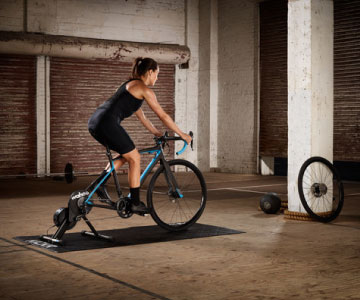
Direct Drive
Direct drive trainers are the most efficient, accurate, and the highest quality. They take the place of your rear wheel and use their own cassettes so you are directly engaging with the system. These trainers will often have advanced features like app connectivity, natural-feeling balance, and more realistic ride quality.
Pros:
More natural ride feel
Most models offer wireless app connectivity
Better efficiency and resistance control
Quieter than a friction trainer
Cons:
Higher price tag than friction trainers
More involved setup sometimes requires a special rear cassette
Slower to take bike in and out of the trainer
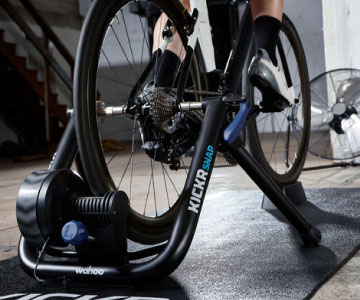
Friction
Friction trainers apply resistance to your rear tire and therefore allow you to keep your rear wheel on. These types of trainers are usually simpler, less expensive, and more portable, but they often don’t have the same features that make direct drive systems feel so realistic.
Pros:
More affordable than a direct-drive trainer
Compatible with most bikes
Folds up for easy storage
Cons:
Friction with rear tire causes wear and noise
Most models don’t have app connectivity
Less stable than direct-drive

Rollers
Rollers are the cheapest way to go and they’re great for riders who want something affordable and super simple that doesn’t require any complicated set up. Just pop your bike on and ride, but although it may sound simple, this style requires the most technique and balance.
Pros:
Great practice of bike handling skills
Easy to set up
Compatible with all bikes
Cons:
Learning curve to balance on rollers
No resistance settings
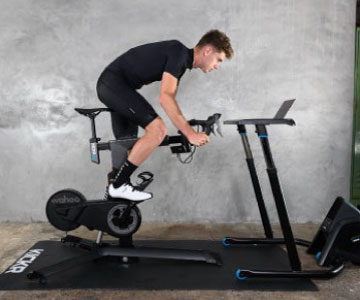
Bike Simulator
Bike simulators provide the most realistic training experience and are designed to work with interactive training apps. The design can be a dedicated simulation bike or involve a gradient simulator that raises and lowers the bike’s front fork.
Pros:
Closest experience to a real bike
Highly adjustable and stable setup
Keeps your bike free for outdoor riding
Designed for use with interactive training apps
Cons:
Most expensive type of bike trainer
Large footprint requires sufficient indoor space
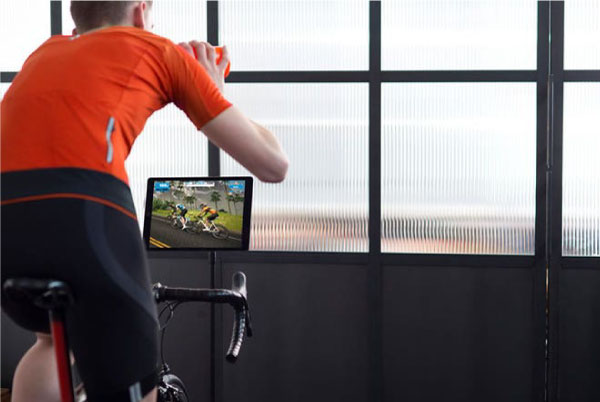
What are Smart Trainers?
Smart trainers, sometimes called virtual bike trainers, are any system that remotely connects to an app and can adjust resistance along with that app.
If you want to race against your friends on Zwift or experience an ultra-realistic ride quality that closely mimics real terrain, smart trainers are the way to go.
Trainer Apps
The experience of indoor cycling has been revolutionized by interactive training apps. These virtual training platforms communicate with your smart trainer to provide real-time stats and guide you through your workout program. You’ll want a phone, computer, or TV screen to connect to the app and show the ride.
Many of these apps now have virtual ride simulations where you can watch your realistic ride on a screen and connect with other cyclists across the globe. You can pick famous routes to explore or design your own path. Users can see metrics from their smart trainer or heart rate monitor such as power output, speed, and cadence up on the screen to stay motivated.
Years ago, quality apps were few and far between but now there are several platforms, including Zwift, TrainerRoad, Wahoo X, FulGaz, Rouvy, and BKool. They are great ways to avoid monotonous indoor sessions and spice up your cycling workouts! Be sure to check that your smart trainer is compatible with your desired training app.
Fluid vs. Magnetic/Electromagnetic Resistance
Fluid resistance: Bike trainers with fluid resistance operate with a flywheel or propeller that spins through a liquid, creating the resistance. The resistance gradually increases the faster you pedal but can’t be adjusted in increments. Fluid trainers tend to be quieter and offer a more realistic, outdoor-like ride feel.
Magnetic/electromagnetic resistance: Trainers with magnetic or electromagnetic resistance enable users to adjust the level of resistance themselves. Magnetic systems are typically controlled via a lever-actuated cable on the handlebars whereas electromagnetic systems can be adjusted on an app or by the smart trainer. The internal flywheel has rotating magnets that determine the resistance amount. The ability to increase and decrease resistance allows for wider training options and compatibility with virtual training rides.
Flywheels
Flywheels maintain the momentum and trainers use different designs of flywheels. When you stop pedaling a trainer with a light flywheel, for example, the wheel will slow down quickly and require more effort to get up to speed again. A heavier flywheel offers a more realistic ride feel— this effect can also be enhanced via a system of internal pulleys.
What are the best indoor bike trainers?
We think indoor trainers are perfect for tons of riders. There's plenty out there to choose from, but here are some of our favorites:
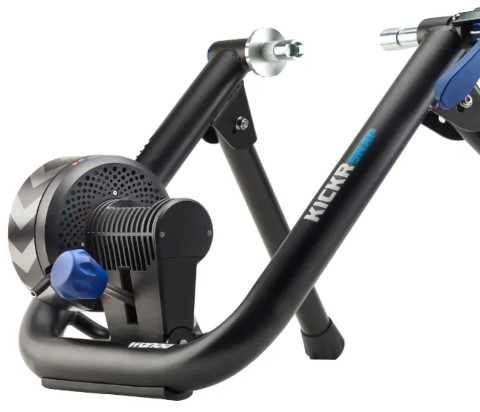
Wahoo KICKR SNAP
- Style: Friction
- Why you'll love it: Besides being an affordable yet top-notch smart trainer, the Wahoo KICKR SNAP allows slight side-to-side movement which helps make the ride quality feel more natural.
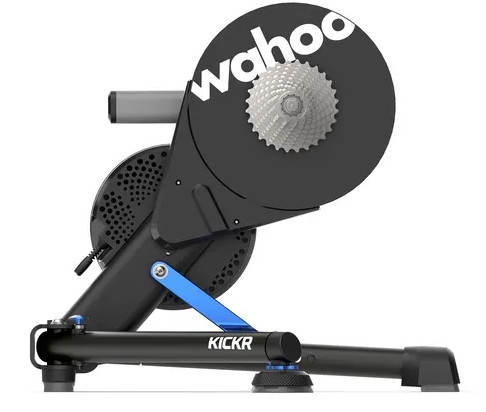
Wahoo KICKR
- Style: Direct Drive
- Why you'll love it: Similar to Kickr Core, but the Kickr comes with a higher power curve, records your mileage, offers WiFi connectivity, and sports a new race mode for faster power-up in competitive situations.
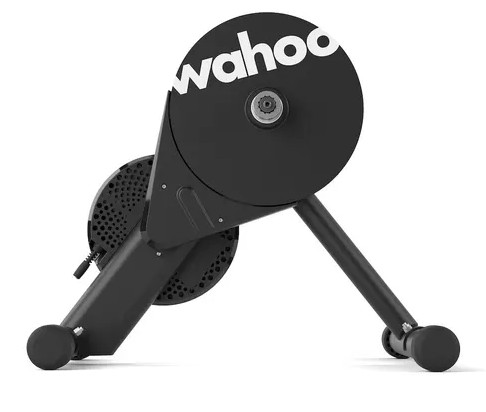
Wahoo KICKR CORE
- Style: Direct drive
- Why you'll love it: The premium Wahoo KICKR CORE trainer is quiet, extra durable, and features built-in cadence measurement for riders who are serious about their training sessions.
What are the most important accessories for indoor cycling?
If you want the best indoor cycling experience possible, there are a few must-have accessories and helpful tips that will keep you comfortable and having fun.
Heart rate monitor: Smart trainers and cycling apps can connect with heart rate monitors so you can see just how hard you’re working.
Phone/computer/TV screen: Training apps like Zwift need a screen to display your virtual ride. Position your screen of choice in front of your trainer and enjoy the immersive experience.
Hydration and nutrition: Like with any workout, you’ll need to stay hydrated as you sweat. Keep water and your favorite workout snacks nearby so you can fuel up during the session or recover afterwards.
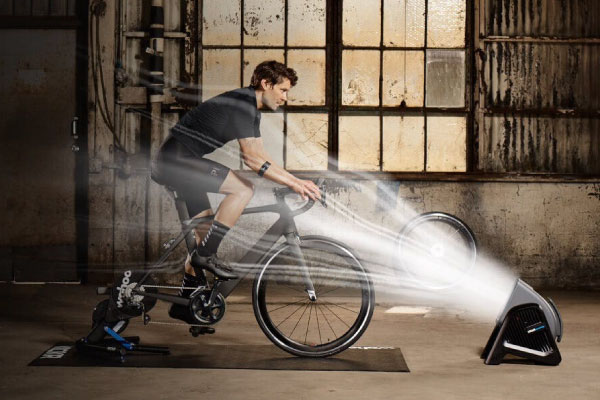
Get a fan: Since you wont have the breeze drying off some of your sweat as you ride, set up a fan or two pointed at your body to help simulate the natural air flow effects.
Grab a sweat guard: Even with a few fans going, indoor cycling is sweaty business, and you'll want to protect your frame and components from all that salt. Use a towel or a specially made sweat guard to keep your bike clean while you workout.
Use a floor mat: Aside from protecting against (you guessed it, sweat), putting a floor mat down will ensure your trainer doesn't slip or scratch your floor in any way.
Set Up Your Training Space
Indoor bike trainers require a decent amount of room, so consider where your workout space will be before you buy. Any space your bike will fit can work and having a table or shelf in front means you can watch your screen of choice or use training apps. Also, angling a fan at yourself as you ride is the best way to stay cool.
If you want to leave your trainer out, it’s a good idea to position it out of the way of the most heavily trafficked places in your home. You’ll be sweating a lot, so it’s recommended to place a workout mat under the bike. Indoor trainers can produce some noise and many riders prefer to use them in spaces away from quieter places in the house— a garage or dedicated workout room are common spots for bike trainers.
Bike Trainer FAQs
How do bike trainers attach?
The vast majority of direct drive and friction trainers attach to your bike's rear axle. Direct drive trainers use their own cassettes and take the place of your rear wheel, while friction trainers add resistance directly to your rear tire. Roller trainers don't attach to your bike.
Can you turn a regular bike into an exercise bike?
With a bike trainer stand you can turn your own bicycle into an indoor exercise bike that's cheaper and more fun than a regular stationary bike.
Can you stand on a bike trainer?
Yes, as long as you attach your bike to the trainer correctly, it will hold up even when you're out of the saddle.
Is a bike trainer a good workout?
Absolutely. Because you have to pedal against the resistance of the trainer, riding indoors can even be more of a workout than riding outside. Trainers, just like the name suggests, are a huge part of many athletes' regimen.
How do I choose a bike trainer?
Read the section on trainer styles above that goes into more detail, but think about the features you want your trainer to have. For example, do you want something lightweight and simple like a regular trainer stand or roller, or do you want something a little heavier that offers more features? Are you serious about training to the point you want to replicate outdoor cycling as closely as possible, or do you just need something to help keep you moving in the offseason? Do you want to connect to virtual cycling apps? If you can answer some of these questions, you'll be able to find the right style for your goals in the Trainer Styles section above.
Are trainers bad for your bike?
No. Normal wear on your components is unavoidable as you ride your bike, but trainers are very low impact. If you have a friction trainer, you may want to use a trainer tire to prevent unnecessary wear on your regular road tire.
Do bike trainers fit all bikes?
Roller trainers will work with just about any bike as long as you can adjust the wheelbase accordingly, but for the other types of trainers you'll want to read the details of each specific model and cross reference that with your bike to ensure it will fit. Don't hesitate to give our team a call if you're not sure and we will gladly help you find a solution.
Can you put a mountain bike on a trainer?
Yes, many mountain bikes will work with the different types of bike trainers, but again, be sure to check out the specs of the specific model you're looking into before buying.
